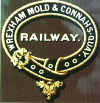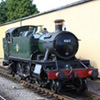LSWR operation; horse boxes
-
ben mason
- Posts: 43
- Joined: Thu Dec 11, 2014 12:17 am
LSWR operation; horse boxes
A question regarding prototype operation, and in my case concerning the LSWR; were horse boxes usually attached to passenger trains, or were they ever to be seen in goods train formation? My layout is planned to have a short siding with a bay for a horsebox but I'm unsure what other stock I can run the horse box with.
-
billbedford
Re: LSWR operation; horse boxes
ben mason wrote:A question regarding prototype operation, and in my case concerning the LSWR; were horse boxes usually attached to passenger trains, or were they ever to be seen in goods train formation? My layout is planned to have a short siding with a bay for a horsebox but I'm unsure what other stock I can run the horse box with.
The short answer is yes.
The long answer is that loaded horse boxes were invariably attached to passenger trains, but that, because they could be booked to run from just about any station with a dock, positioning moves could be made by goods trains. The same would be true of carriage trucks.
-
Will L

- Posts: 2524
- Joined: Sun Jul 20, 2008 3:54 pm
Re: LSWR operation; horse boxes
Or, if you have local horse race track you can justify a train containing little else.
-
Noel

- Posts: 1981
- Joined: Wed Jun 23, 2010 1:04 pm
Re: LSWR operation; horse boxes
I can't comment on the LSWR specifically, but some time ago I looked through my books and magazines for evidence on this question. Virtually all photographs were post-grouping or BR, but NPCS appeared in a small but noticeable proportion of the goods train photos, often in low category trains. Possible reasons are
1] failures in traffic being removed after repair
2] empties being delivered [stations where horse boxes, for example, were not allocated required notice to be given]
3] empties being removed from the arrival station
4] vehicles in transit to/from repair shops
Loaded horse boxes would travel by the quickest available means normally, which was not always a passenger carrying train, but there was no reason why empties being delivered to a station for loading [if the timing was not a problem], or being removed empty to their home station, should not travel as part of the local goods, rather than delay a passenger train just to deliver or collect empty stock. As Bill says, the same applies to carriage trucks, also Special Cattle Vans, scenery trucks, fish vans (quite common), parcels vans, etc.
Noel
1] failures in traffic being removed after repair
2] empties being delivered [stations where horse boxes, for example, were not allocated required notice to be given]
3] empties being removed from the arrival station
4] vehicles in transit to/from repair shops
Loaded horse boxes would travel by the quickest available means normally, which was not always a passenger carrying train, but there was no reason why empties being delivered to a station for loading [if the timing was not a problem], or being removed empty to their home station, should not travel as part of the local goods, rather than delay a passenger train just to deliver or collect empty stock. As Bill says, the same applies to carriage trucks, also Special Cattle Vans, scenery trucks, fish vans (quite common), parcels vans, etc.
Noel
Regards
Noel
Noel
-
BryanJohnson

- Posts: 181
- Joined: Wed Jul 23, 2008 7:45 pm
Re: LSWR operation; horse boxes
Again, not LSWR specific, but would the rules be different if there was a groom travelling in the box with the horse? Would this make it a passenger rated vehicle, with implications for needing a continuous brake etc.?
-
Noel

- Posts: 1981
- Joined: Wed Jun 23, 2010 1:04 pm
Re: LSWR operation; horse boxes
Grooms accompanying horses did not count as passengers, but all NPCS was passenger rated. NPCS was always equipped with automatic power brakes once these became a legal requirement; they couldn't run in passenger trains otherwise [not quite true, I know, but true for practical purposes]...
Noel
Noel
Regards
Noel
Noel
-
Andy W

- Posts: 884
- Joined: Thu May 21, 2009 8:11 am
Re: LSWR operation; horse boxes
I think when possible a horse box would be coupled next to the engine to ensure as smooth a ride as possible.
Make Worcestershire great again.
Build a wall along the Herefordshire border and make them pay for it.
Build a wall along the Herefordshire border and make them pay for it.
-
ben mason
- Posts: 43
- Joined: Thu Dec 11, 2014 12:17 am
Re: LSWR operation; horse boxes
Thanks for sending your comments, I am starting to get a picture of how I should operate. Loaded deliveries or departures should be attached to passenger trains, and next to the engine for a more comfortable ride for the passengers. Empty vans could be positioned by goods trains as has been pointed out. If you feel my ideas could be corrected at all please don't hesitate to send further comments!
-
BryanJohnson

- Posts: 181
- Joined: Wed Jul 23, 2008 7:45 pm
Re: LSWR operation; horse boxes
For my prototype, there was a local trainer who would send horses to the races by rail. Assuming that this was still common practice in 1951, it will make an interesting addition to the layout's operation.
The station is an intermediate station on the branch, with a suitable side and end loading dock so that's OK. However, I can't see any horseboxes being shunted into or out of the scheduled passenger trains. The goods yard would be served by the pick up goods, which wasn't necessarily worked by a vacuum fitted engine. If the groom was travelling with the race horse, would this need a special working by a vacuum fitted engine or would the horse and groom have a slow trip with the pick up goods, possibly to the terminus and then back to the junction, depending on which direction the yard was worked from on that day?
Bryan
The station is an intermediate station on the branch, with a suitable side and end loading dock so that's OK. However, I can't see any horseboxes being shunted into or out of the scheduled passenger trains. The goods yard would be served by the pick up goods, which wasn't necessarily worked by a vacuum fitted engine. If the groom was travelling with the race horse, would this need a special working by a vacuum fitted engine or would the horse and groom have a slow trip with the pick up goods, possibly to the terminus and then back to the junction, depending on which direction the yard was worked from on that day?
Bryan
-
andrewnummelin
- Posts: 374
- Joined: Mon Jul 21, 2008 9:43 am
Re: LSWR operation; horse boxes
Andy W wrote:I think when possible a horse box would be coupled next to the engine to ensure as smooth a ride as possible.
I would have thought that the opposite was likely to be the case - surging from a steam loco will reduce the further back in the train you are (continuous brakes, taught couplings, buffers in compression). Loose coupled goods trains would be a different matter.
Regards,
Andrew Nummelin
Andrew Nummelin
-
jon price

- Posts: 641
- Joined: Mon Jun 07, 2010 2:34 pm
Re: LSWR operation; horse boxes
Just reading an accident report. Horse box immediately behind engine on passenger train derailed. Inspector said should have been coupled at the rear of the train. Horse boxes at front of goods trains to give them smoother ride as if they were at the back the snatching of the three links could be quite uncomfortable.
Connah's Quay Workshop threads: viewforum.php?f=125
-
Will L

- Posts: 2524
- Joined: Sun Jul 20, 2008 3:54 pm
Re: LSWR operation; horse boxes
BryanJohnson wrote:.. However, I can't see any horseboxes being shunted into or out of the scheduled passenger trains. ..
Things were more leisurely in those days, I think that is exactly what they did. Whether it turned up at the front or rear would eventually depending on what was easiest given the layout of the station.
-
BryanJohnson

- Posts: 181
- Joined: Wed Jul 23, 2008 7:45 pm
Re: LSWR operation; horse boxes
I've done a quick check and to add / detach a horsebox from a passenger train would need full use of the station, i.e. no crossing train in the other direction, no other wagons blocking the yard that needed to be moved, and would take:
For an up train, 8 separate loco movements with the horse box being placed immediately behind the engine;
For a down train, 10 separate loco movements with the horse box at the end of the train.
Add to this putting the handbrake on the coaches whilst they are sitting at the platform before releasing the engine, then checking the restoration of the vacuum once everything is coupled up again before releasing the handbrake. Driver, fireman, signalman and guard would need to be a well-co-ordinated team but I think you'd still do well to achieve this in much under 15 minutes. This ad-hoc delay would likely spoil connections at the junction, or lose the path if the train continued on the main line.
I'm still undecided between:
Add it to a passenger train,
Run as a special train, or
Put it in the pick-up goods.
On the positive side, the passengers in 1951 would be spared numerous announcements over the tannoy, and there was a café right next to the station if needed.
Bryan
For an up train, 8 separate loco movements with the horse box being placed immediately behind the engine;
For a down train, 10 separate loco movements with the horse box at the end of the train.
Add to this putting the handbrake on the coaches whilst they are sitting at the platform before releasing the engine, then checking the restoration of the vacuum once everything is coupled up again before releasing the handbrake. Driver, fireman, signalman and guard would need to be a well-co-ordinated team but I think you'd still do well to achieve this in much under 15 minutes. This ad-hoc delay would likely spoil connections at the junction, or lose the path if the train continued on the main line.
I'm still undecided between:
Add it to a passenger train,
Run as a special train, or
Put it in the pick-up goods.
On the positive side, the passengers in 1951 would be spared numerous announcements over the tannoy, and there was a café right next to the station if needed.
Bryan
-
jon price

- Posts: 641
- Joined: Mon Jun 07, 2010 2:34 pm
Re: LSWR operation; horse boxes
Eight loco movements?, or two:
Uncouple loco, pull forwards past the turnout.
Bring out Dobbin the station's shunting horse and move the horse box out of the way.
Back loco onto the train and couple up
Uncouple loco, pull forwards past the turnout.
Bring out Dobbin the station's shunting horse and move the horse box out of the way.
Back loco onto the train and couple up
Connah's Quay Workshop threads: viewforum.php?f=125
-
Will L

- Posts: 2524
- Joined: Sun Jul 20, 2008 3:54 pm
Re: LSWR operation; horse boxes
Special movement of this sort would be organised and planed before the event. It was not a case of the train turning up and the station master telling the driver, oh yes there is this horse box over there that you need to take away. The horse box would be loaded and ready and positioned conveniently before the arrival of the train. It would be quite likely that a second loco or a shunting hours would be ready to assist in attaching it to the train, particularly if time was tight.
Also I'm inclined to do wonder about your track layout. End loading docks, where this sort of vehicle would be loaded, were specifically arranged so as to make moves required as easy as possible.
What is not in doubt is the fact that In the early days of the railways, the rich would regularly have their coach and horses conveyed by being attached to a train. Clearly this sort of thing died out as the years went by, but I'm sure elements of it persisted through the pregrouping period at the very least, and the attachment of vehicles to passenger trains was still going on in BR days. One of the problems with diesel rail cars was they weren't much good at pulling a trailing load.
Anyway, according to the thread title, you were talking about LSWR operations. 1951?
Also I'm inclined to do wonder about your track layout. End loading docks, where this sort of vehicle would be loaded, were specifically arranged so as to make moves required as easy as possible.
What is not in doubt is the fact that In the early days of the railways, the rich would regularly have their coach and horses conveyed by being attached to a train. Clearly this sort of thing died out as the years went by, but I'm sure elements of it persisted through the pregrouping period at the very least, and the attachment of vehicles to passenger trains was still going on in BR days. One of the problems with diesel rail cars was they weren't much good at pulling a trailing load.
Anyway, according to the thread title, you were talking about LSWR operations. 1951?
-
Dave K

- Posts: 247
- Joined: Sun Jul 20, 2008 6:11 pm
Re: LSWR operation; horse boxes
Ben,
Although not LSWR but in issue no. 76 of the Great Western Railway Journal there is a 14 page article about Horsebox Traffic on the GWR including a number of photos of horseboxes in use.
Dave
Although not LSWR but in issue no. 76 of the Great Western Railway Journal there is a 14 page article about Horsebox Traffic on the GWR including a number of photos of horseboxes in use.
Dave
-
Joe Newman
- Posts: 64
- Joined: Tue Aug 11, 2009 8:25 pm
Re: LSWR operation; horse boxes
In Maurice Earley's long out of print 'The Great Western Scene' (OPC), there is, on page 37, a 1938 picture of a Didcot to Newbury train in Upton and Blewbury station. It is made up of loco, three coaches, with two horseboxes bringing up the rear.
This picture always reminds me of a friend of my father's who spent her early years living in Blewbury. She recounted the story of standing on Upton and Blewbury station and asking the porter "How long will the train be for Newbury?"
The answer - "Three coaches and a horsebox!
Joe
This picture always reminds me of a friend of my father's who spent her early years living in Blewbury. She recounted the story of standing on Upton and Blewbury station and asking the porter "How long will the train be for Newbury?"
The answer - "Three coaches and a horsebox!
Joe
-
billbedford
Re: LSWR operation; horse boxes
Andy W wrote:I think when possible a horse box would be coupled next to the engine to ensure as smooth a ride as possible.
I don't think that was the reason. It was more likely that it was easier, especially at small rural stations, for the train engine to shunt the horse box, or any other vans, than to shunt with the whole train. OTOH when delivering npcs it was easier to just drop the van off the back of the train and have the station staff move it into its siding. Having said that, the layout of the station in question would determine the simplest way of dealing with vans and therefore whether they were attache to the front or back of the train.
-
jon price

- Posts: 641
- Joined: Mon Jun 07, 2010 2:34 pm
Re: LSWR operation; horse boxes
billbedford wrote: Having said that, the layout of the station in question would determine the simplest way of dealing with vans and therefore whether they were attache to the front or back of the train.
And this is likely to be the over-riding factor. Also we know that some stations were only shunted in one direction so this might affect which trains were carrying NPCS. In working timetables sopme fast trains (even though they might stop at a particular station) were excluded from adding horse boxes.
Connah's Quay Workshop threads: viewforum.php?f=125
-
Guy Rixon

- Posts: 910
- Joined: Sun Mar 27, 2011 6:40 pm
Re: LSWR operation; horse boxes
Another reason for having horseboxes only at the head of the train: they may not have automatic brakes! I chanced upon an article (Roger Marsh, The King's Horsebox, MRJ 42, 601) concerning some GER horseboxes modified by the LNER. "At first these vehicles were dual-fitted Westinghouse and vacuum, operated through clasp brakes. A single handbrake was fitted to one side. The braking system was simplified from the early 1930s by removal of the Westinghouse and seven of the brake shoes, leaving the primitive, single-shoe handbraked arrangement but retaining through vacuum pipe (AVP)."
-
Noel

- Posts: 1981
- Joined: Wed Jun 23, 2010 1:04 pm
Re: LSWR operation; horse boxes
Will L wrote:One of the problems with diesel rail cars was they weren't much good at pulling a trailing load.
GWR and BR diesel railcars were generally not too bad at this, some, indeed, being specifically designed for trailing loads. Steam railcars, however, were notoriously feeble...
Guy Rixon wrote:Another reason for having horseboxes only at the head of the train: they may not have automatic brakes!
The rules for through piped vehicles were complex, but didn't always exclude them from being at the rear of the train, although it was permitted only in certain trains and circumstances.
jon price wrote:Bring out Dobbin the station's shunting horse and move the horse box out of the way.
Shunting horses were only used where there was sufficient work to keep them and their handlers busy for most of the day. Small branch stations could rarely achieve this, so a porter with a suitable lever is a possibility, but as previously observed, most small branch goods yards were arranged so that a vehicle could be picked up or dropped in one shunt.
Noel
Regards
Noel
Noel
-
Armchair Modeller
Re: LSWR operation; horse boxes
There would be other horses around that could unofficially be borrowed for a bit of shunting - like the local coal merchant's beast(s) or from people making collections and deliveries at the goods yard. Country folk would have been good at helping each other out in t' old days.
I remember reading somewhere that even in the nineteen fifties, a local goods yard had assistance from the local coal merchant's lorry and a rope when a bit of shunting was required to move wagons around in a country goods yard.
I remember reading somewhere that even in the nineteen fifties, a local goods yard had assistance from the local coal merchant's lorry and a rope when a bit of shunting was required to move wagons around in a country goods yard.
-
martinT
Re: LSWR operation; horse boxes
There's been a thread on this topic on RMWeb, see:
http://www.rmweb.co.uk/community/index.php?/topic/96502-horses-catching-trains-how-were-they-loaded/
towards the end I've added a couple of links to photos shewing horseboxes being detached & attached at Dulverton.
Martin
http://www.rmweb.co.uk/community/index.php?/topic/96502-horses-catching-trains-how-were-they-loaded/
towards the end I've added a couple of links to photos shewing horseboxes being detached & attached at Dulverton.
Martin
-
Will L

- Posts: 2524
- Joined: Sun Jul 20, 2008 3:54 pm
Re: LSWR operation; horse boxes
Liked the photo's Martin, particularly and the second one which answers the question as to whether they would set back a whole passenger train to pick up/set down a wagon.
Who is online
Users browsing this forum: ClaudeBot and 0 guests